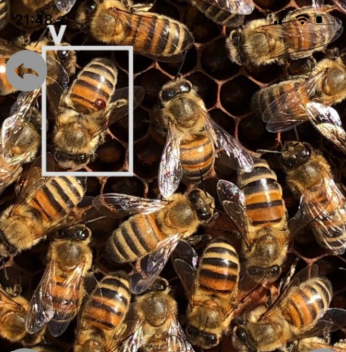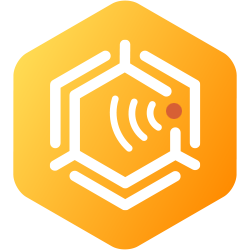Smartphone vs. Mites: What We Learned from Testing the BeeScanning App
Each year, nearly 20 million honey bee colonies are lost—many due to Varroa destructor and Varroa jacobsoni, which are parasitic mites that threaten honey bee health around the world. On top of these pesky parasites, pollinators are up against habitat loss, pesticides, and the impacts of industrial agriculture (among other things). For any beekeeper, staying ahead of a mite infestation is one of the most critical—and often most difficult—parts of hive management that we can attempt to control.
New Tech for a New World
At Buddha Bee, we recently did a short trial run with the BeeScanning App, a promising digital tool designed to help beekeepers monitor colony health with minimal disruption to the bees. Rather than using alcohol washes or sugar shakes, BeeScanning uses your phone’s camera and artificial intelligence to assess hive conditions. You simply take a series of close-up photos of bees on the comb, upload them through the app, and receive fast results.
The results provide estimated mite load—including hidden mites within capped brood—and potential signs of brood disorders like foulbrood, chalkbrood, uncapping behavior, and parasitic mite syndrome. When the app detects a brood disorder, it highlights it in green as shown below. We believe that the photo on the left is simply an accidental drone in a sea of worker brood, while the photo on the right is demonstrating hygienic bees and their uncapping behavior.
BeeScanning was launched in 2016 and is now used worldwide by both researchers and hobbyist beekeepers. It’s powered by the largest manually annotated bee photo database in the world and continues to improve as more scans are submitted.
Getting started is straightforward. After setting up a hive profile in the app, you snap about eight clear photos (typically four per side of a brood frame), then let the AI do the work. The analysis highlights visible mites, calculates an estimated infestation level based on comparisons with traditional tests, and flags any suspicious brood patterns. While the app doesn’t replace the traditional alcohol wash or sugar shake mite tests, it’s a bee-friendly way to check for issues more frequently. Routine scans—ideally every 2 to 4 weeks—can help catch problems before they grow.
Traditional Testing Methods: Alcohol Wash vs Sugar Shake
At Buddha Bee, we use the sugar shake method to check for varroa mites in our hives.
This choice can be considered controversial, since the alcohol wash is seen as the “gold standard” for accuracy in testing. Both tests involve taking about 300 bees (roughly ½ cup) and placing them in a mason jar with a mesh lid (or some other mite testing contraption).
With the sugar shake, we add powdered sugar through the mesh lid of the jar and gently roll it around to coat the bees. After a few minutes, the sugar encourages the mites to fall off and the bees to groom themselves (exactly what triggers the detachment is still somewhat up for debate). We then shake the jar over a container and count the number of mites that fall through the mesh. The bees are then returned to the hive, alive. In contrast, the alcohol wash uses rubbing alcohol instead of sugar. The alcohol kills the bees and the mites but ensures that all mites are dislodged, making it more accurate than the sugar shake.
So why do we choose the sugar shake anyway? At Buddha Bee, we inspect every hive 14–18 times per year, depending on what each colony needs. At almost every visit (except during winter months), we run a mite test. Because of how frequently we monitor, we’re comfortable using the sugar shake method—even though it’s slightly less accurate.
To compensate, we test and treat our colonies proactively:
In spring, we treat with Varroxsan if we find 2 or more mites.
In summer, we use Apiguard if we see 4–5 or more mites, or Varroxsan for 2–4 mites.
In fall, we treat with Formic Pro or Varroxsan using similar thresholds to summer.
In winter, we apply multiple rounds of Oxalic Acid Vapor (this is the only time of year we do not mite test before and after treating).
While older guidelines used to recommend treatment at 3% infestation (about 9 mites per 300 bees), newer advice now lowers that to 2% (6 mites). Since the sugar shake may miss some mites, we treat at just 1% (4 mites) to stay ahead of it. This approach—frequent monitoring, lower treatment thresholds, and varied seasonal treatments—has helped us maintain healthy, thriving colonies.
App Accuracy vs Sugar Shake Testing
Testing Period: July 15–23, 2025
Methods Used: Sugar Shake Mite Tests and the BeeScanning App across multiple hosted colonies
Goal: Compare the app's predictions to real mite test results to determine its reliability in assessing whether treatment is needed. To clarify, when doing the calculations behind these numbers, the mite test results were transformed into % infestation for a more accurate comparison.
Test Totals
19 total colonies were tested. From this, there were 8 colonies that needed treatment and 11 colonies that did not need treatment based on the sugar shake test.
App Accuracy
The app correctly identified whether treatment was needed 63% of the time, meaning it was off the mark 37% of the time.
To give a few examples:
In one case, a hive had a mite count of zero, but the app reported a 2% infestation—a false positive.
On the flip side, another hive had 9 mites (3% infestation), but the app reported 0% infestation—a clear false negative.
Sometimes, though, the app was on track. For example, one hive had a mite count of 20, and the app estimated 4% infestation. The actual infestation rate would be closer to 7%, but at least it picked up on the problem.
We also had multiple hives with a zero mite test result, and the app correctly reported 0% infestation for those.
It’s worth noting that our sample size was quite small, and some of the inaccuracy could be due to user error. Taking clear photos of moving bees on frames—especially with shadows, sun glare, and buzzing wings in the way—isn’t always easy. That’s the joy (and challenge) of working outdoors with bees all day!
Error Breakdown
We had 5 false negatives, which were cases where the app said no treatment was needed, but the sugar shake showed treatment was necessary. We had 2 false positives, which means the app flagged the hive for treatment but the sugar shake results were actually low.
The app was more prone to underestimating mite levels, which poses a greater risk to colony health than false positives. A missed treatment can allow mites to multiply unchecked, increasing the chance of disease and total colony collapse. False positives, while not ideal, are less harmful—especially if you’re using gentler treatments like Varroxsan. However, over-treating can still stress the bees or build miticide resistance over time, so accuracy certainly matters on both sides.
What These Results Tell us
BeeScanning offers beekeepers a quick, non-invasive way to get a snapshot of what’s happening inside the hive. It’s a promising example of how modern technology can support healthy, sustainable beekeeping practices.
From our experience, the app is more likely to miss hives that actually need treatment than to flag healthy hives by mistake. While it can serve as a helpful guide, it should never replace hands-on mite testing—especially when treatment decisions depend on hitting specific thresholds.
We also noticed the app sometimes mislabels brood disorders or even misidentifies mites on bees (see photos below). The photo on the left has a slightly open brood capping, which could very well be a brood disorder, however the smaller “bd” square appears to just be an uncapped larvae that has not reached the correct age to be capped yet. In the middle photo, the app mistakenly labeled a visible mite on a bee when one wasn’t present, but the brood pattern was spotty—something we associate with Parasitic Mite Syndrome. In this case, our mite test came back with a count of 6, so while the app didn’t get the full picture, it did sense that something was wrong. The photo on the right is labeling a moving bee as a “bd,” which just goes back to what was previously mentioned about user error and blurry photos.
While we had fun experimenting with the BeeScanning app during our trial run, we ultimately decided not to continue using it. If the accuracy had been a bit stronger, it might have been worth the effort—but the time it takes to snap photos, still perform a mite test, and then analyze the results just didn’t justify the payoff. That said, we really love the concept and hope the app continues to improve. With better accuracy and a more streamlined user experience, it has real potential to become a valuable tool for beekeepers around the world.







